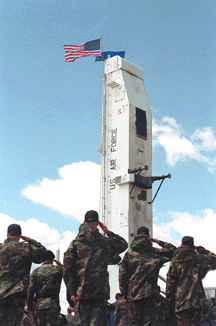| SAC Bases: Grand Forks
Air Force Base |
|
|
|
|
Grand Forks AFB is located 14 miles west of the city of Grand Forks.
Grand Forks has a population of close to 50,000 and is home of the
University of North Dakota. Grand Forks is located in the Heart of the Red
River Valley near the forks of the Red Lake River and the Red River of the
North. The quality of life in this community has been ranked by Money
Magazine as one of the top communities in the nation. Low crime, good
schools and medical facilities, as well as great shopping, a variety of
restaurants and short commutes are just a part of what make Grand Forks a
nice place to live and raise a family. |
Air Defense
During the early 1950s, as the Cold War
between the United States and the Soviet Union continued, the US Air Force
announced plans to build an Air Defense Command (ADC) fighter-interceptor base
in eastern North Dakota. Sixty-five thousand dollars was donated by community
minded citizens towards the purchase of a 5,400-acre tract of land 15 miles west
of the city of Grand Forks. The Defense Department chose Grand Forks as the site
for the new installation in 1954.
Contractors began construction of the base with
grubbing operations for the12,350-foot runway on February 6, 1956. The initial phase of construction was completed in 1960 when the 18th Fighter Interceptor Squadron and the Grand Forks Area
Defense Sector, semi-automated ground environment began building
operations with the F-101 Voodoo.
SAC Tankers and Bombers
The same month that construction of the runway began,
February 1956, the Air Force announced that it would build-up Grand Forks AFB to
support Strategic Air Command (SAC) bombers and tankers besides ADC
fighters-interceptors. The KC-135 Stratotanker arrived in May 1960, making
it the first Strategic Air Command weapon system to arrive.
The Strategic Air Command transferred the 30th Bombardment Squadron (BMS)
(Heavy) from Homestead Air Force Base, Florida, to Grand Forks, assigning it to
the 4133rd Strategic Wing, a tenant organization. The 30th acquired its first B-52H Stratofortress on
April 29, 1962. On February 1, 1963, the Strategic Air Command organized the
319th Bombardment Wing (Heavy) at Grand Forks AFB, replacing the 4133rd
Strategic Wing. In July of the same year, SAC assumed command and control of the
base. Under 2nd Air Force, the base became home of the 4th Strategic Aerospace
Division.
First Minuteman II Missile Wing
On November 1, the command organized the nation's first
Minuteman II intercontinental ballistic missile wing, the 321st Strategic
Missile Wing (SMW), while construction began on a Minuteman II missile complex.
The 321st SMW became operational with the Minuteman II in December 1966.
Construction began for the 321st SMW to upgrade to Minuteman IIIs in 1972,
and this project was completed on March 8, 1973. In 1975, the newly-activated
57th Air Division brought the two wings together under its control. In 1983, the
319th Bombardment Wing transitioned from B-52H to B-52G bombers. The wing
swapped its B-52Gs for B-1B Lancers, while acquiring KC-135Rs, in 1987. The
319th Bomb Wing was deactivated May 26, 1994, with the departure of the last
B-1B.
Identified in 1995 for realignment by the Defense Base Closure and
Realignment Commission, the 321st Missile Group now has a dual mission: To
operate, maintain and secure combat-ready ICBM forces for the National Command
Authority and to safely and securely transfer its alert responsibilities to the
341st Missile Wing at Malmstrom Air Force Base, Montana.
In 1970, the base was placed under the operational control of the 15th Air Force. In 1971, the 4th STRAD was transferred to F.E.
Warren AFB, Wyoming, as the 4th Strategic Missile Division. At this
time, the missile wing was redesignated the host wing for the base. In 1973, the 321st received the Minuteman III. In 1975, the newly-reactivated 57th Air Division brought the two
wings together under its control.
With the departure of the B-52 in December 1986, came the arrival of
the B-1B Lancer. The base received its first of 17 B-1B Lancers and
newly re-engined KC-135s in October 1987. The 42 Air Division gained operational command and control of Grand
Forks AFB in June 1989. The move resulted in the inactivation of some
missile wing units. Activated in their place were several 842 units. The
move also placed the base under 8th Air Force. In July 1991, the air division inactivated, making the 319th
Bombardment Wing the host unit, activating several 319th units.
In September 1991, the wing was renamed the 319th Bomb Wing. On June 1, 1992, Grand Forks AFB, the 319th Bomb Wing and the 321st
Missile Wing said goodbye to SAC and became part of the new Air Combat
Command, as a result of major Air Force-wide reorganization. On July 1st, 1993 the 321st Missile Wing became part of the Air
Force Space Command.
On October 1, 1993 as part of the ongoing Air Force restructuring,
the 319th Air Refueling Wing was activated and the base was aligned
under Air Mobility Command. The 319th Bomb Wing was redesignated the
319th Bomb Group. Grand Forks AFB is the first supertanker wing in the
Air Force. On July 1st, 1994 the 321st Missile Wing was redesignated as the
321st Missile Group as a result of a command level reorganization.
The base continues to be the home of the 321st Missile Group which
operates and maintains 150 Minuteman III intercontinental ballistic
missiles in a complex which covers 7500 square miles of eastern North
Dakota. On May 26, 1994 the last of the B-1's left Grand Forks AFB and the 319
Bomb Group was officially deactivated.
The base employs approximately 4,800 military members and 500
civilians. Overall, the base population exceeds 12,000. The annual base
payroll is in excess of $133 million. |
|
 |
Last Minuteman missile leaves
Grand Forks |
| |
|
|
|
